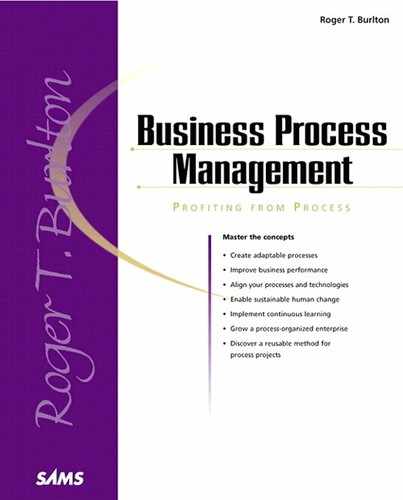Developing Enablers and Support Mechanisms
The purpose of the Develop phase is to develop in detail all components for all releases of the business process solution. During this phase, an organization will build or change all the supporting mechanisms required for the new process to work according to stakeholder requirements.
Results
In the Develop phase, an organization develops and constructs the infrastructures for facilities, technology, and human core competencies. It also defines or redefines policies and rules, jobs, and organizational structures, and realigns HR incentives. It develops and tests all technologies, hardware, software, and networks. The training capability is also made ready.
Concepts Handled
Figure 5.10 depicts the concepts dealt with in the Develop phase.
Concept Knowledge Reused
The whole point of the Develop phase is to bring to life all the ideas created in previous phases. All the work done previously occurred only so that you could be in this position.
The future state solution design gives you the requirements, definition, or basis for producing a lot of related deliverables in different professional areas. It depicts what the process workflow will be, what information and knowledge will be needed, what triggering events are in play, and what responses will be required. You can tell what technologies are required and what they have to do, what people will be responsible for, and how they should be organized. You can relate the business rules to their process of usage.
This design is the basis for training materials and ongoing knowledge distribution that you’ll use to build the infrastructures needed for technology and facilities and also to educate staff and other stakeholders about the way of doing business. You can also use them to ensure that the other deliverables of this phase are consistent with a set of design principles and interface standards. In this way, the results of other initiatives underway or to come will fit.
When you enter the Develop phase, you need the guidance of the stakeholder criteria used in all phases and the transformation strategy produced in the Renew phase. Test all deliverables as well as the overall solution using the scenario test cases. Use these also as the basis for training cases and reference material examples. Don’t forget that stakeholder concerns must still be managed as they change, and the communication strategy must be exercised frequently.
Concept Knowledge Created
Based on the great work that you’ve done to date in coming up with a better way of working, you now have the opportunity to build that better way. Because you have a transformation strategy and a process solution design, you can do a lot of the building concurrently. Be sure, however, to manage the synchronicity for fit and avoid miscommunications.
Develop the process to its required level of detail, covering the roles that people will have to assume. Also develop and gain approval for the detailed business rules required and write procedures if you have to. Don’t embed the rules if you can avoid it.
Develop the guidance that will affect the human resources involved with conducting and managing the work. You might have to develop new job descriptions, skills, competency definitions, and organizational models. Likewise, human resource policies might have to be updated. You might also have to build knowledge transfer enablers, such as education programs and specific training courses in whatever media you will use.
Facilities take time to arrange and build, so start as soon as you are confident of the solution’s match to needs. Physical infrastructures are especially time-consuming to get going, and delays can prevent you from meeting your planned dates. Specialized equipment can cause you headaches to acquire, especially if you have to navigate a convoluted purchasing process. Some equipment and facilities can be inextricably linked to technology and information flow if you are building real-time controls into production facilities and have to link business and production systems and data together.
Information technology isn’t unlike facilities and equipment in its potential complexity. Start early to build IT infrastructures such as networks, operating and control systems, and data management integration capabilities. You don’t have to know the details of your applications to do some of this. You can test the connectivity of information appliances (such as handheld devices into the wireless network) before you write code.
You can choose to buy commercial, off-the-shelf software or build your own solutions. The requirements will be more confidently known because of the future state solution design built around complete processes with integrity. Use the scenarios and process maps to make sure that the vendors and your developers show you complete scenarios, and not just partial or functional views of their offerings.
All of this will give you an integrated solution ready for testing or rollout to the business. If it is just for one release of the solution, the Develop phase could go on for some time until all releases are complete.
Steps
The following steps are recommended to populate the concepts of the Develop phase. They are described in detail in Chapter 15, “Developing Capability for the Renewed Process”:
1. | Build physical infrastructures. |
2. | Provide human core capabilities. |
3. | Build computing infrastructure. |
4. | Develop processes, procedures, and rules. |
5. | Redefine jobs. |
6. | Design organizational changes. |
7. | Update human resources policies. |
8. | Develop/integrate technology and systems. |
9. | Develop training capability. |

